Hip dysplasia is one of the hereditary health conditions a lot of large dogs are prone to. But, have you ever wondered what the German Shepherd hip dysplasia symptoms are?
Can we notice those first subtle signs that there is something wrong with our GSDs hip joint? Or, is it just the late stages of this condition we can actually notice?
Is this a condition that only older dogs suffer from, or can I notice the signs in my German Shepherd puppy as well?
These are some of the questions we are going to talk about in this text. It’s all about hip dysplasia, but more importantly, German Shepherd hip dysplasia.
From limping and lameness to total avoidance of movement — let’s talk about one of the major health problems in German Shepherds and other medium to large dog breeds.
There are 11 symptoms you can look out for and (hopefully) notice early on so that you and your veterinarian can act during the early stages of this progressive health condition.
German Shepherd Hip Dysplasia Symptoms
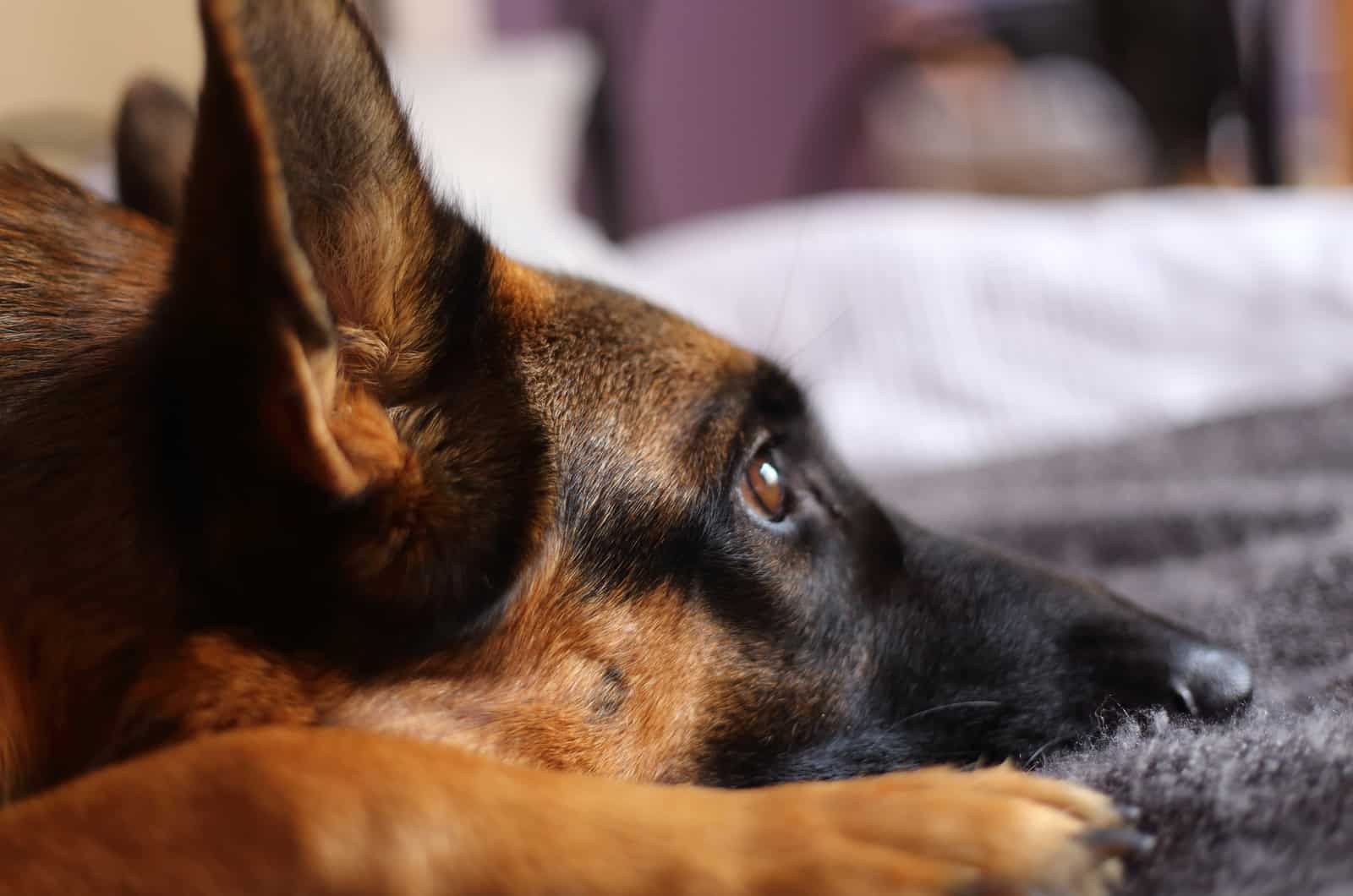
The full name for this condition is Canine hip dysplasia, and the abbreviation we will use throughout the text is CHD.
Hip dysplasia is, in essence, the abnormal growth of the hip joint. The hip consists of the ball (femur’s head/femoral head), and the socket in the acetabulum (pelvis). Hip dysplasia happens when these two bone structures do not grow (develop) at the same speed.
The result is the looseness of the hip joint represented in various symptoms. Lastly, the body will try to treat this condition on its own, which further causes problems — osteoarthritis or degenerative joint disease.
There are 11 German Shepherd hip dysplasia symptoms we will talk about. Even though we focus on GSDs (because almost 20% of all GSD puppies eventually suffer from this condition), you can use these symptoms to examine other dogs with CHD predisposition.
For example, Labrador Retrievers, Golden Retrievers, Great Danes, Saint Bernards (and other giant breeds of dogs).
Let’s get into it…
1. Less Activity
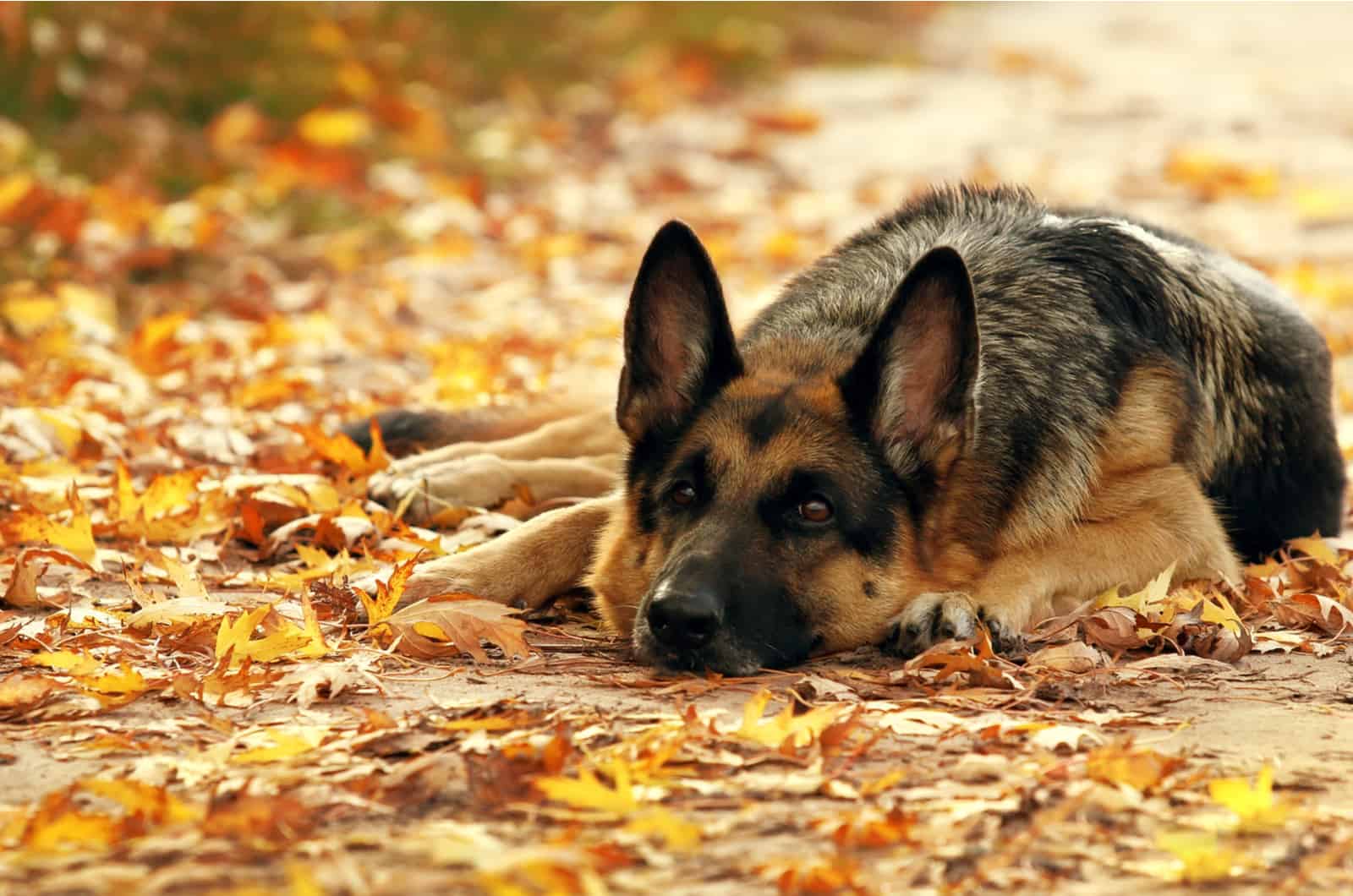
One of the first symptoms of hip dysplasia that dog owners notice is that their dogs are not as active as they used to be. And, for a dog breed such as the German Shepherd, this can be quite strange.
We are used to our furry friends being active, wanting to play, or going on a walk. However, we notice they are not as keen to doing any kind of activity as they were before.
Most people won’t think of CHD right away. Most people will think their dogs have some other kind of health condition, perhaps a viral or bacterial infection, or problem with digestion.
However, German Shepherd hip dysplasia‘s first symptom is exactly this — less activity than usual.
2. Difficulty Getting Up
Another clinical sign there is something wrong with the hip socket is when your German Shepherd has a problem getting up from the lying position.
It’s not that he doesn’t have the strength – it’s the fact that he has a rather dysfunctional ball and socket joint preventing him from doing it properly. This is a sign you can notice in young dogs as well.
This German Shepherd hip dysplasia symptom is also connected to joint laxity (looseness). Once again, we say GSD hip dysplasia, but this can be a symptom of any other large breed dog.
3. Difficulty Running
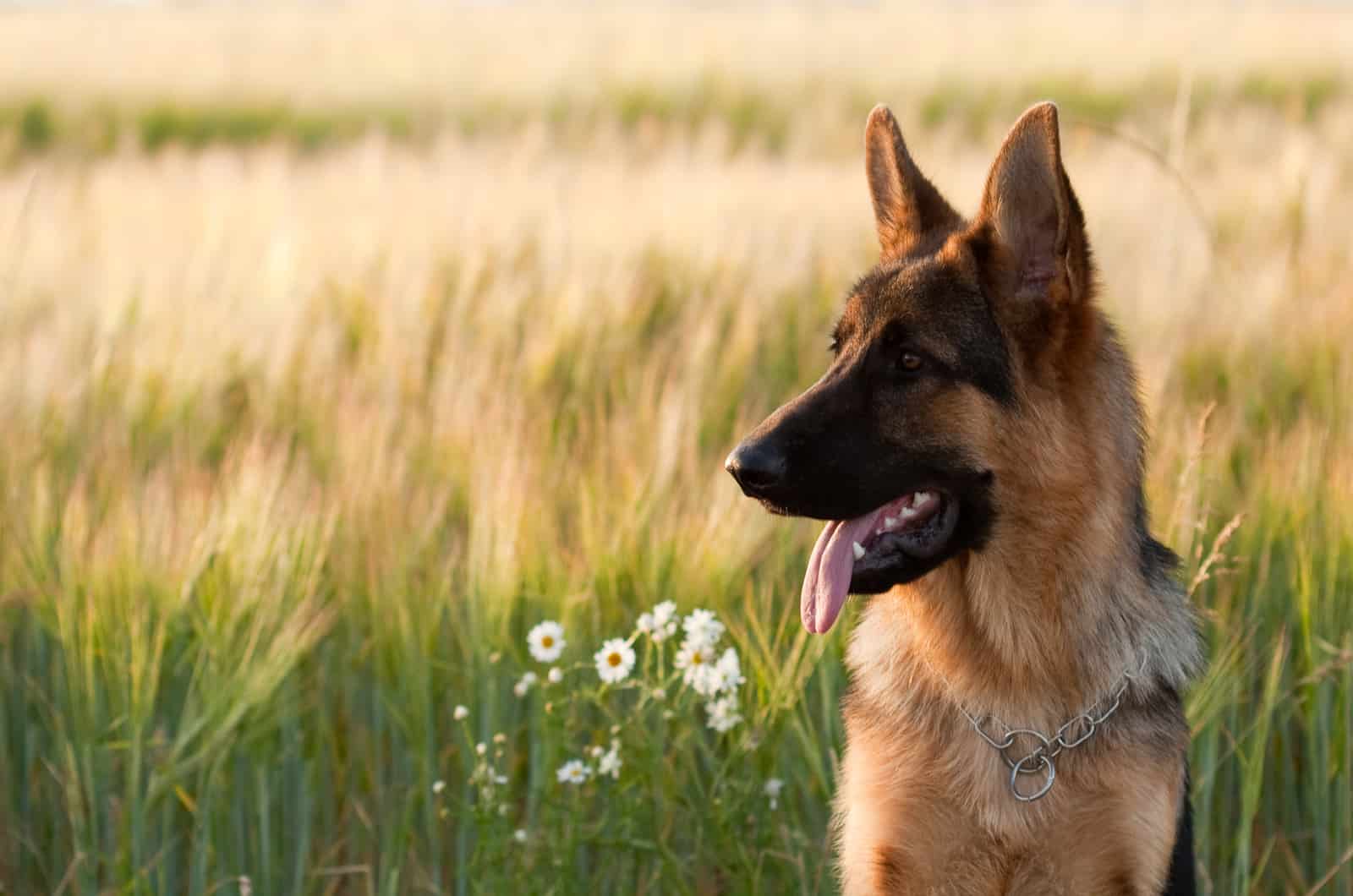
Together with difficulty getting up, another dog hip dysplasia symptom is difficulty running, jumping, or going up and down stairs.
Now, if you have a GSD, no matter if it’s purebred or a GSD mix, one of the traits is its high energy and desire to be active. So, when you notice that your dog doesn’t run as it used to, can’t go up and down stairs, etc. — something’s wrong.
And, that something is the ongoing development of hip dysplasia.
4. Bunny hop gait
Bunny hop (or bunny gait) is one of the signs of hip dysplasia that is often mentioned when breeders or dog owners talk about hip problems in dogs.
Basically, it means a dog is using both back legs at the same time to walk or run. With normal joint health, a dog will move one hind leg forward and then the front leg on the same side.
That’s why it is very noticeable when a dog “hops” like a bunny; hence, the name bunny gait. This movement happens because the dog is either feeling pain or it cannot move its legs as it wants to.
5. Limited Movements

You will notice another symptom — your dog has limited movements. What does this mean? It can’t stretch its hind legs, which first starts as “funny walking” or running, but ends up as bunny hopping.
Eventually, a dog will avoid using the affected leg. However, we don’t want to reach that stage. The sooner we notice a dog has limited movements, the better. As with any disease or health condition, time plays an important role in treatment.
6. Limping and Lameness In Hind Legs
Lameness means the inability of a dog to properly use one or more legs. Because of this, a dog starts to limp while walking. Both lameness and limping can be seen in other health conditions. A dog might have a hurt leg or a paw.
However, upon examination, and combined with other symptoms, lameness and limping are common signs of hip dysplasia in dogs.
It is the German Shepherd hip dysplasia symptom that dog owners notice. This is because it is quite evident that something is bothering our dog.
7. Loss Of Hip Muscle Mass
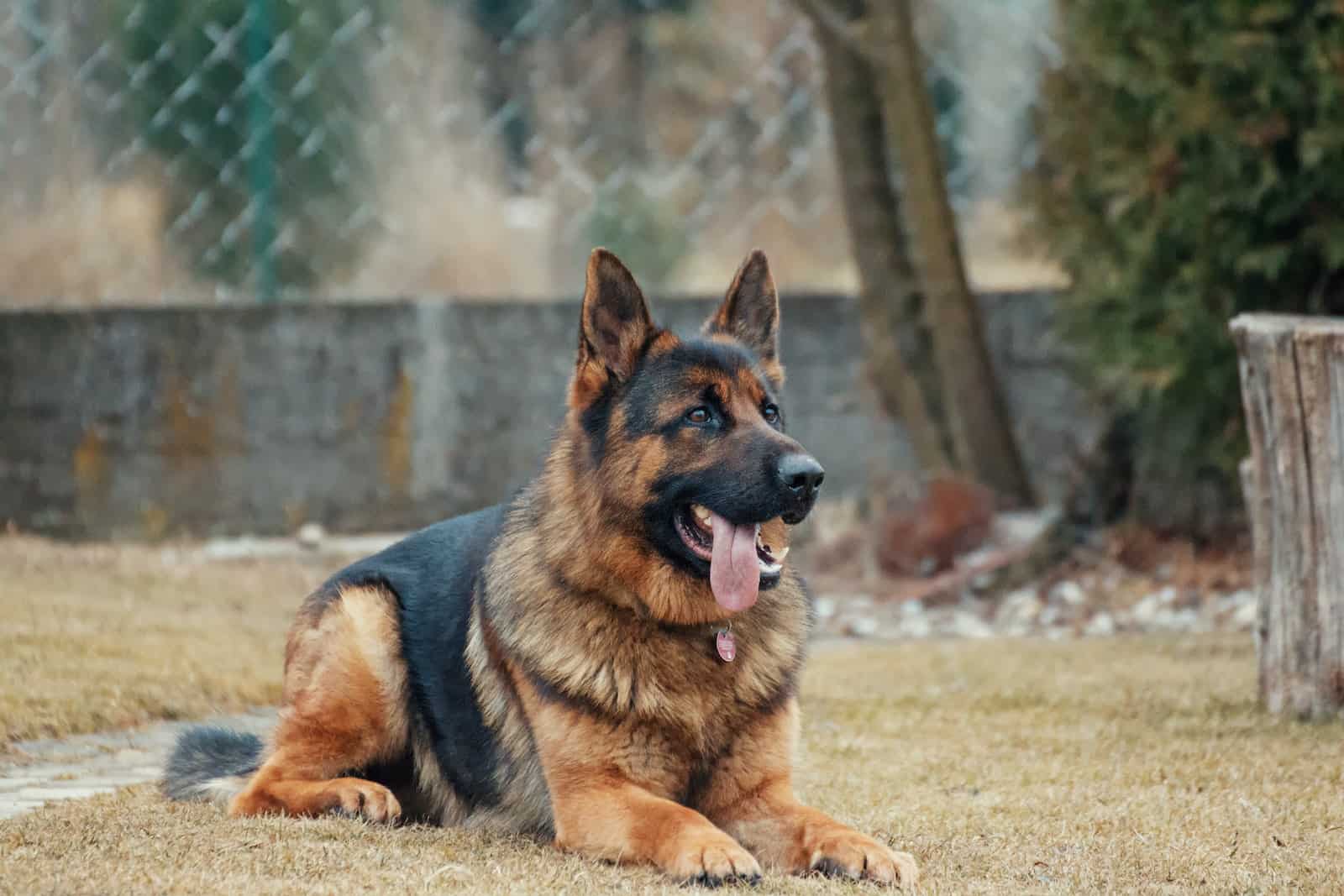
When a dog stops using its hind legs or avoids using them, the muscles will eventually atrophy, and it will look as if your dog has thin back legs.
This is a symptom referred to as loss of muscle mass. It is not directly connected with hip dysplasia, but indirectly. Hip dysplasia causes the dog to stop or avoid using its back legs, which then leads to muscle mass loss.
It is a common occurrence in all mammals that stop using a limb because of an injury or a health condition. Depending on the disease or condition, the muscle mass can be enlarged through proper exercise or physical therapy.
8. Larger Shoulder Muscles
A dog’s body compensates for the loss of muscles on the hind legs by using the front legs and shoulder muscles more often. Your dog did not skip leg day at the gym – he is only using the only fully functional joints to help himself move — shoulders.
So, to support the weight and the pressure caused by it, the muscles need to be bigger and stronger to support the bones and prevent breaking or shoulder dislocation.
9. Pain
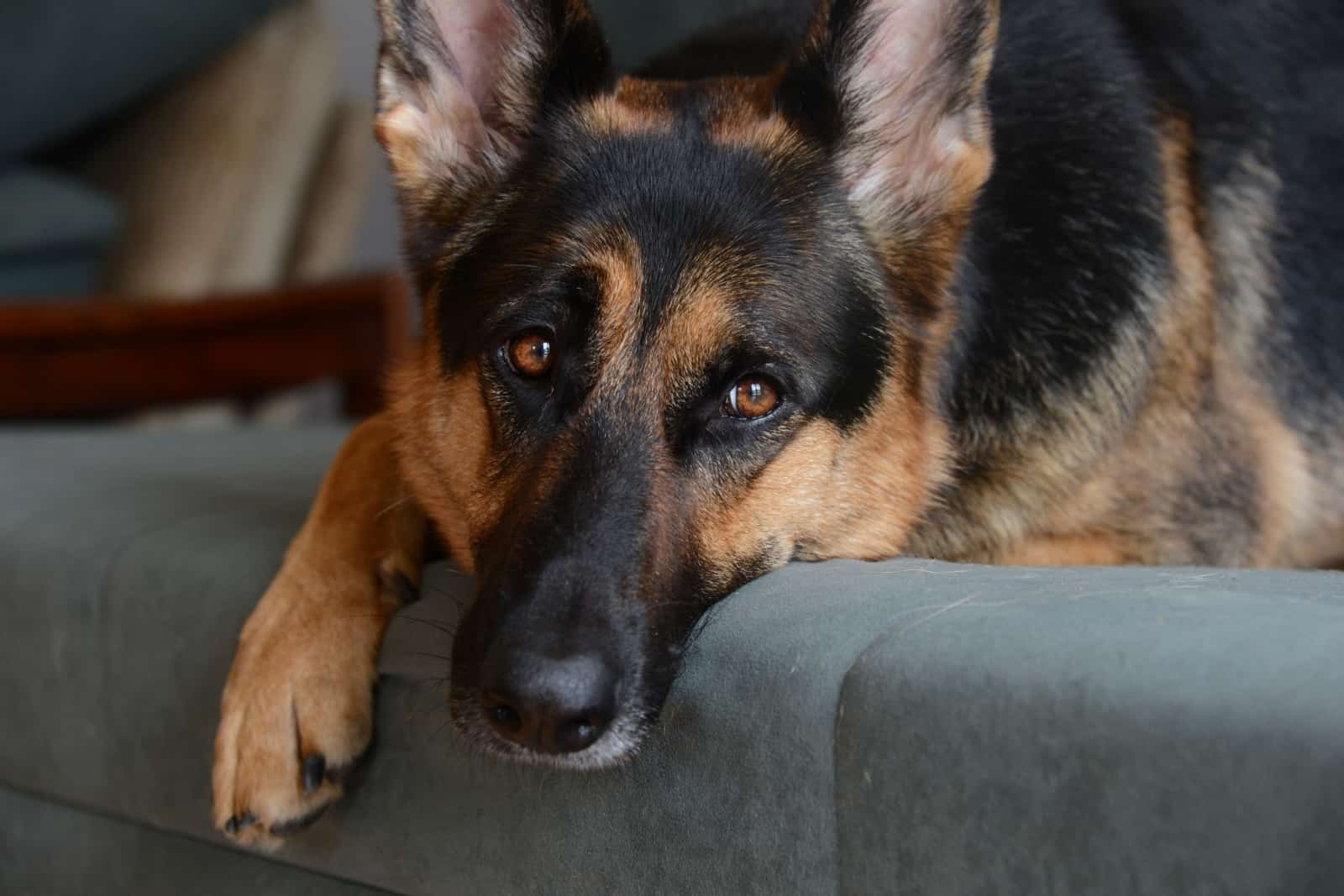
One of the reasons for the previously-mentioned limited range of motion is joint pain. It happens during movement, when two bones rub on each other without cartilage in between as a cushion, which results in painful bone spurs.
Osteoarthritis and degenerative joint disease is the response of the body to these bone spurs and painful joint movements. The body is trying to protect itself by making the hip joint stiff.
Read Next: Puppy Crying At Night In The Crate
10. Stiffness
This is our next German Shepherd hip dysplasia symptom — stiffness. It happens as a result of the direct contact between the femur and the acetabulum, which is very painful.
The stiffness of the affected leg is the dog’s way of trying to avoid movement and prevent further pain. The pain and deterioration of the joint are greater in dogs that suffer from obesity, so regulation of weight gain is a must.
Read Next: How Heavy Should My Dog Be?
11. Grating During Movement
Grating (or grinding) during movement is a sign of osteoarthritis. It’s what we hear when two mentioned hip bones rub on each other.
There is no cartilage to prevent this from happening, and cartilage cannot repair or “grow” on its own. Because of this, hip dysplasia is a progressive disease that needs to be taken care of surgically if it comes to this final part.
What Are The Treatment Options?

If you suspect your GSD has hip dysplasia, the first thing you need to do is take him to the vet. Then, the vet can do the necessary examination — radiographs, OFA testing (Orthopedic Foundation for animals), X-rays, or pennHIP, as well as examination of clinical signs.
After a proper diagnosis, your vet will recommend a treatment option depending on the state in which your dog is in, or rather — his hips.
If the pain is not severe, or if the CHD has been noticed in its early stages, a DVM can suggest:
- Non-steroidal anti-inflammatory drugs (NSAIDs)
- Glucosamine
- Chondroitin
- Joint supplements
- Weight loss (maintaining a healthy weight)
If the pain is too great or a dog’s quality of life is severely impaired, the other option is surgical intervention:
- Juvenile pubic symphysiodesis
- Triple pelvic osteotomy (TPO)
- Femoral head ostectomy (FHO)
- Total hip replacement
Finally, as an alternative option, your vet can recommend acupuncture as a form of treatment.
The Conclusion
As you can see, German Shepherd hip dysplasia has many symptoms that we can notice even in the early stages of the disease. However, if we don’t know where to look, we cannot see it.
Symptoms can happen in young dogs and in adult dogs, but we cannot predict when the first symptoms start to show. It could be years or months.
The first symptoms could be severe or mild. They might be connected to your dog’s weight or amount of exercise. We don’t know what triggers the first symptoms simply because we cannot see inside the hip at the time, and dogs are unable to tell us when they feel the first discomfort in the joint.
So, the best thing is to pay attention to your dog’s behavior during playtime or exercise, and see if he might be avoiding certain movements or avoiding using one of his legs.
If you do notice it — take your GSD to the vet.













